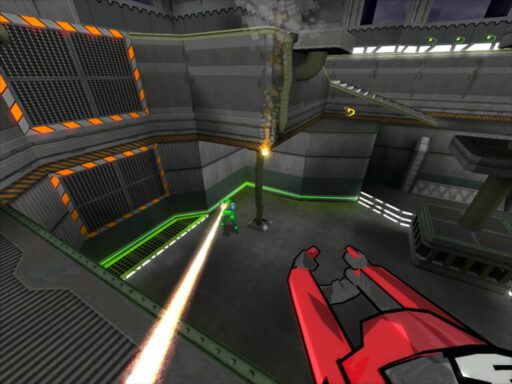First Person Shooter (FPS) games have captivated the hearts of gamers worldwide, offering an adrenaline-fueled escape into virtual battlefields. From the pixelated corridors of early classics to the sprawling, realistic arenas of modern titles, FPS games have undergone a dramatic transformation. This article delves into the evolution of FPS games, exploring their origins, rise to fame, and the innovative future that lies ahead. We’ll uncover how these games have shaped the gaming industry and what makes them a perennial favorite among players.
Key Takeaways
- FPS games have evolved from simple maze-like environments to complex, story-driven experiences with realistic graphics and physics.
- Online multiplayer has transformed FPS games into a social phenomenon, fostering communities and competitive esports scenes.
- The introduction of mobile FPS games like Call of Duty Mobile and Fortnite has expanded the genre’s reach, allowing on-the-go gaming without compromising on quality.
- Technological advancements such as virtual reality and AI are set to further enhance the immersive experience of FPS games.
- FPS games continue to innovate, with new mechanics, storytelling techniques, and cross-platform play, ensuring their place in the future of gaming.
The Birth of Bullet Battles: Tracing the Origins of FPS Games

The Early Days: Maze War and Spasim
The genesis of first-person shooter (FPS) games can be traced back to the 1970s with the creation of Maze War and Spasim. These pioneering games laid the groundwork for what would become a genre defined by adrenaline-pumping action and immersive gameplay. Maze War introduced the concept of navigating a 3D maze from a first-person perspective, a revolutionary idea at the time. Meanwhile, Spasim, released in 1974, offered a rudimentary multiplayer experience, allowing players to engage in space combat with one another.
The simplicity of these early games belies their profound impact on the industry, setting the stage for the complex and visually stunning shooters of today.
While rudimentary by today’s standards, these games were technological marvels that captivated the imaginations of players. They were the precursors to a genre that would explode in popularity in the decades to follow. Here’s a brief comparison of their features:
- Maze War:
- First-person perspective
- Multiplayer capabilities
- Maze navigation
- Spasim:
- Space combat simulation
- Real-time multiplayer
- 32-player games
The legacy of Maze War and Spasim is evident in the DNA of modern FPS games, which continue to evolve and push the boundaries of what is possible in video game design.
The 90s Boom: Doom, Quake, and GoldenEye 007
The 1990s heralded a new era for first-person shooters, with titles like Doom, Quake, and GoldenEye 007 leading the charge. These games not only pushed the boundaries of what was technically possible at the time but also introduced a level of interactivity and immersion that had previously been unattainable.
- Doom set the stage with its fast-paced action and networked multiplayer, becoming a cultural phenomenon.
- Quake took things a step further with fully 3D environments and real-time rendering.
- GoldenEye 007 for the Nintendo 64 redefined what a console FPS could be, offering a compelling single-player campaign and pioneering split-screen multiplayer.
The impact of these games was profound, influencing countless titles that followed and establishing the FPS as a dominant genre in the gaming industry. The 1990s was a pivotal decade for the evolution of FPS games, setting a foundation that would shape the future of interactive entertainment.
The Rise of Online Multiplayer: Counter-Strike and Halo
The turn of the millennium marked a pivotal moment in the evolution of FPS games with the advent of online multiplayer capabilities. Counter-Strike and Halo became the torchbearers of this new era, offering gamers unprecedented ways to compete and cooperate with players across the globe.
- Counter-Strike, originally a mod for Half-Life, quickly escalated into a phenomenon due to its tactical gameplay and community-driven updates.
- Halo, on the other hand, redefined console multiplayer with its seamless matchmaking and iconic maps, fostering a loyal fanbase.
The synergy between accessible online play and the social dynamics of gaming communities propelled the FPS genre into a mainstream entertainment powerhouse.
The impact of these games is evident not just in their enduring popularity, but in the way they shaped the expectations for online interactions in gaming. They set the stage for a future where online play would become a staple, rather than a novelty, in the gaming experience.
Modern Warfare: The Rise of Tactical and Realistic Shooters

The Call of Duty Phenomenon
The Call of Duty series has become a cornerstone in the landscape of first-person shooters, captivating millions with its intense gameplay and cinematic experiences. The franchise’s success is not just limited to consoles and PCs; it has also made a groundbreaking leap into mobile gaming.
- Legendary Maps: Players can battle across iconic locations from the series, such as Nuketown and Hijacked.
- Personalized Loadouts: A deep customization system allows for personalized arsenals.
- Diverse Multiplayer Modes: From Team Deathmatch to Battle Royale, the game offers a variety of competitive playstyles.
The mobile iteration of Call of Duty has managed to distill the essence of its console counterparts into a form that’s not only accessible but also remarkably robust, offering a full-fledged shooter experience on the go.
The game’s ability to bring a high-quality FPS experience to mobile devices has set a new standard for what is possible in mobile gaming. It has shown that the adrenaline-fueled action of Call of Duty can be enjoyed anytime, anywhere, without compromising on the depth and engagement that fans have come to expect.
Battlefield’s Large Scale Warfare
The Battlefield series revolutionized the FPS genre with its emphasis on large-scale battles and extensive maps. Players are thrust into expansive warzones, where coordination and strategy are just as important as individual skill. The game’s focus on vehicular combat and environmental destruction adds layers of complexity to the traditional shooter formula.
- Strategic Team Play: Squads must work together to capture and hold objectives.
- Vehicular Combat: Tanks, aircraft, and other vehicles play a pivotal role.
- Destructible Environments: Buildings and structures can be demolished, altering the battlefield.
- Class-Based Roles: Players choose from distinct classes, each with unique abilities.
The allure of Battlefield lies in the chaotic symphony of war it orchestrates, where every player’s action can turn the tide of battle. The game’s persistent emphasis on teamwork and tactics has cemented its status as a staple in the genre, offering a contrast to the more traditional, close-quarters combat of its contemporaries.
The Influence of Realism in Rainbow Six Siege
Ubisoft Montreal’s development of Tom Clancy’s Rainbow Six Siege marked a significant shift towards realism in the FPS genre. The game’s emphasis on strategy and team play over sheer firepower challenged players to think tactically, mirroring real-world special operations forces.
The game’s realistic graphics and destructible environments have set a new standard for immersion, compelling players to use the environment to their advantage and anticipate enemy actions. This level of detail extends to the audio design, where sound cues become critical for survival.
Rainbow Six Siege’s success is a testament to the appeal of realism in video games. It has cultivated a dedicated community that values skill, strategy, and precision.
The game’s influence is evident in the rise of tactical shooters that prioritize realism over arcade-style gameplay. As developers continue to push the boundaries of what’s possible, Rainbow Six Siege remains a benchmark for realism in the genre.
Mobile Frontlines: The Impact of FPS Games on Mobile Gaming

Call of Duty Mobile: A Console Experience on the Go
Call of Duty Mobile revolutionizes mobile gaming by seamlessly bringing the renowned first-person shooter franchise to smartphones and tablets. Players immerse themselves in a rich gaming environment, drawing inspiration from blockbuster titles like Modern Warfare and Black Ops.
Engage in thrilling multiplayer battles with customizable loadouts, strategic killstreaks, and numerous game modes, from classic team deathmatch to heart-pounding battle royale showdowns. Experience the adrenaline rush of intense combat right at your fingertips with Call of Duty Mobile.
- Diverse Multiplayer Modes: Call of Duty Mobile presents an array of engaging multiplayer modes to cater to every player’s preference. Whether you enjoy the adrenaline rush of Team Deathmatch, the strategic gameplay of Search and Destroy, or the thrill of dominating in Domination, there’s always a new challenge awaiting you in the game.
- Legendary Maps: Immerse yourself in iconic battlegrounds from the renowned Call of Duty universe. Traverse through familiar terrains and engage in combat that feels both nostalgic and fresh.
The mobile platform has been transformed into a battleground where the lines between console and mobile gaming experiences are increasingly blurred. Call of Duty Mobile stands as a testament to the potential of mobile gaming, offering a full-fledged FPS experience that rivals its console counterparts.
Fortnite: Building a Bridge Between Platforms
Fortnite has emerged as a pioneer in cross-platform play, seamlessly connecting players across various devices. This breakthrough has not only expanded the game’s reach but also fostered a more inclusive gaming community. The game’s ability to unite players regardless of their preferred platform is a testament to its design philosophy, which emphasizes accessibility and social interaction.
The game’s features, such as the iconic Battle Royale mode and the innovative building mechanics, have been instrumental in its success. Players can express their creativity in Fortnite’s Creative mode or personalize their avatars with a wide array of skins and accessories, further enhancing the game’s appeal.
Fortnite’s continuous updates and events keep the gameplay fresh and the community engaged, ensuring that the game remains a dynamic and evolving platform for gamers worldwide.
The Growth of Indie Mobile Shooters: POLYWAR and Modern Ops
The mobile gaming landscape has been significantly enriched by the emergence of indie first-person shooters, which offer a console-like experience on handheld devices. POLYWAR and Modern Ops stand out as prime examples of this trend, delivering engaging gameplay and competitive action to a rapidly growing audience.
Indie developers have successfully captured the essence of FPS gaming with titles that are not only visually appealing but also boast a high degree of playability. The following table showcases the user ratings of some notable indie FPS games on the Google Play Store:
| Game Title | Developer | Google Play Rating |
|---|---|---|
| POLYWAR | Azur Interactive Games Limited | 4.2 stars |
| Modern Ops | Edkon Games GmbH | 4.6 stars |
| Fire Strike | Edkon Games GmbH | 4.4 stars |
| MaskGun | SuperGaming | 4.0 stars |
The indie FPS genre on mobile platforms is a testament to the creativity and innovation of developers who are not afraid to challenge the status quo and provide gamers with fresh and exciting experiences.
As the market for mobile FPS games expands, new titles continue to emerge, offering diverse gameplay mechanics and unique features. One such title is Taddle Quest, which, although not strictly an FPS, enriches the genre with its focus on boss battles and equipment rewards.
The Social Aspect of Shooters: From Lone Wolf to Pack Hunter

Clans and Communities: The Social Fabric of FPS
The social dynamics of first-person shooter (FPS) games have evolved significantly, transforming from solitary experiences to complex networks of clans and communities. Clans have become the cornerstone of the FPS genre, offering players a sense of belonging and a structured environment for both casual and competitive play.
- Strategic Gameplay: Players engage in meticulous planning and tactical warfare within their clans.
- Clan Wars: Alliances are forged globally, leading to strategic wars and events that highlight a clan’s strength.
- Diverse Troop Types: Clans often consist of players with different skills and preferences, enriching the gameplay experience.
The allure of FPS games extends beyond the screen, creating a virtual space where friendships are forged and a sense of camaraderie is nurtured. The game becomes a playground for strategic thinking and social interaction, with clans at the heart of this vibrant ecosystem.
The intricate dynamics of alliance-building, resource management, and skillful planning contribute to the game’s lasting appeal and challenge players to think strategically to achieve success.
Esports and Competitive Play: The Rise of Professional Gaming
The esports industry has witnessed a meteoric rise, transforming from a niche community to a mainstream phenomenon. Competitive gaming growth continues to surge as eSports establishes itself as a key player in the confluence of technology, media, and culture. This growth is not just about the players and the games; it’s about the entire ecosystem that supports and enhances the competitive experience.
The allure of esports extends beyond entertainment, creating a virtual playground where friendships flourish and camaraderie thrives.
Developers and marketers play a crucial role in this expansion. By tailoring marketing strategies to enhance visibility, they attract a committed player base. High-quality art and design, along with seamless multiplayer integration, are essential for fostering interactive gameplay experiences that resonate with audiences. Continuous refinement based on user feedback ensures that games remain relevant in the competitive gaming industry.
The table below showcases the diverse roles that contribute to the esports ecosystem:
| Role | Function |
|---|---|
| Game Developers | Create and update games |
| Marketers | Promote games and events |
| Designers | Enhance visual appeal |
| Community Managers | Foster player engagement |
Streaming and Content Creation: A New Avenue for Engagement
The landscape of first-person shooter (FPS) games has been dramatically reshaped by the advent of streaming and content creation. Platforms like Twitch and YouTube have become arenas where gamers not only showcase their skills but also build communities. These platforms have given rise to a new kind of celebrity: the streamer, who can command the attention of thousands of viewers, influencing gaming trends and preferences.
In the realm of FPS games, streamers play a pivotal role in maintaining a title’s popularity. For instance, a game’s presence on streaming platforms can significantly impact its player base and longevity. As an example, consider the following data from a recent report:
| Game Title | Hours Watched (Million) | Rank on Twitch |
|---|---|---|
| Apex Legends | 28.7 | 10th |
This table illustrates the substantial viewership that top FPS games can garner, which in turn fuels their continued relevance and success. The symbiotic relationship between streamers and game developers is also noteworthy; developers often rely on streamers to provide feedback and promote updates, ensuring the game remains relevant and engaging.
The influence of streaming on FPS games extends beyond mere entertainment. It has become a critical component of the gaming ecosystem, driving innovation and player engagement.
As the industry evolves, the interplay between streaming, content creation, and game development will likely deepen, with each element feeding into the other to create a more vibrant and interactive gaming community.
Innovations and Evolutions: The Future of First Person Shooters

Virtual Reality and the Immersion of Tomorrow
The advent of virtual reality (VR) has opened up new horizons for first-person shooter (FPS) games, offering an unprecedented level of immersion. Players can now step into fully realized 3D environments, experiencing the thrill of combat as if they were truly part of the action. This leap forward in gaming technology promises to redefine the boundaries of player engagement and game design.
The potential for VR in FPS games is not just about visual and auditory enhancement, but also about introducing new ways to interact with the game world. The tactile feedback from VR controllers adds a layer of physicality that traditional gaming has lacked, making every action more impactful.
The integration of VR in FPS games is not without its challenges, however. Developers must consider factors such as motion sickness and the physical space required for play. Despite these hurdles, the future of VR in FPS games is bright, with many developers already experimenting with innovative features:
- Realistic Weapon Handling: Simulating the weight and recoil of firearms for a more authentic experience.
- Physical Movement: Encouraging players to duck, dodge, and lean in real-time, enhancing the feeling of presence.
- Social Interaction: Enabling more natural communication and teamwork through VR’s immersive environment.
Cross-Platform Play: Breaking Down Barriers
The advent of cross-platform play has been a game-changer in the realm of first-person shooters, allowing players to engage with one another irrespective of the hardware they own. This feature has not only enhanced accessibility but also unified gaming communities in unprecedented ways.
Games like Fortnite and Among Us have led the charge, demonstrating the vast potential of a connected gaming ecosystem. Fortnite’s success, in particular, can be attributed to its ability to bring together players from different platforms, fostering a more inclusive environment. Similarly, Among Us has capitalized on cross-platform play to create a space where friends can collaborate and compete, no matter the device.
The seamless integration of cross-platform play has become a staple for modern FPS games, ensuring that barriers to entry are minimized and social connections are strengthened.
The following list highlights some of the best cross-platform FPS games, as noted by TheGamer:
- Payday 3
- Overwatch 2
- Tom Clancy’s Rainbow Six Extraction
- Call Of Duty: Warzone
- Enlisted
These titles exemplify the strides made in cross-platform capabilities, offering players a diverse range of experiences while maintaining the core essence of competitive play.
The Role of AI and Machine Learning in Game Development
The integration of Artificial Intelligence (AI) and Machine Learning (ML) in game development is not just a trend; it’s a transformative force reshaping the industry. AI’s influence extends from the core gameplay mechanics to the aesthetics of the virtual worlds we explore. Game engines, the backbone of development, are now equipped with advanced AI capabilities, enabling developers to create more dynamic and responsive gaming environments.
- Game Design: AI algorithms can procedurally generate content, from intricate levels to complex NPC behaviors, offering a unique experience each time a game is played.
- Visual Enhancement: ML techniques are improving graphics rendering, making games more realistic and visually stunning.
- Player Experience: AI personalizes the gaming experience by adapting difficulty and in-game events to the player’s skill level and preferences.
The potential of AI and ML in game development is immense, promising to deliver more immersive and engaging experiences to players. As we look to the future, the role of AI will only grow, influencing design and storytelling, enhancing graphics and visuals, and opening up new possibilities for innovation.
Conclusion
The evolution of first-person shooter (FPS) games is a testament to the genre’s ability to adapt and thrive in a rapidly changing gaming landscape. From the visceral, close-quarters combat of Trepang2 to the strategic depth and mobile revolution of Call of Duty Mobile, FPS games continue to push the boundaries of interactive entertainment. The genre’s expansion into mobile platforms and the continuous innovation in gameplay mechanics, as seen in Fortnite and 1v1.LOL, demonstrate its versatility and enduring appeal. As we’ve explored the adrenaline-fueled world of FPS games, it’s clear that the genre’s future is as bright and explosive as the virtual battlegrounds players love to navigate. Whether it’s through the competitive rush of 1v1 clashes or the immersive experiences offered by new titles, the FPS genre remains a cornerstone of gaming culture, constantly evolving to deliver heart-pounding action to players around the globe.
Frequently Asked Questions
What was the first first-person shooter (FPS) game?
The first FPS game is widely recognized as Maze War, which was developed in the early 1970s and involved players navigating a maze while engaging in combat with other players.
How did Call of Duty Mobile change the mobile gaming landscape?
Call of Duty Mobile brought the renowned FPS franchise to mobile devices with high-quality graphics and gameplay inspired by titles like Modern Warfare and Black Ops. It offers a variety of game modes and customizable loadouts, setting a new standard for mobile FPS games.
What sets Fortnite apart from other multiplayer shooter games?
Fortnite is unique due to its combination of shooting and building mechanics, allowing players to create structures for strategic advantage. Its continuous updates, engaging events, and visually stunning graphics have contributed to its massive worldwide popularity.
What is the appeal of indie mobile shooters like POLYWAR and Modern Ops?
Indie mobile shooters like POLYWAR and Modern Ops offer players a diverse range of fast-paced and competitive gameplay experiences. They often bring innovative mechanics and are accessible to a wide audience, providing a fresh alternative to mainstream mobile FPS games.
How has the social aspect of FPS games evolved over time?
The social aspect of FPS games has grown from individual play to a community-focused experience. Clans and gaming communities, along with the rise of esports and streaming, have created a rich social fabric that enhances player engagement and creates a sense of belonging.
What potential does virtual reality (VR) hold for the future of FPS games?
Virtual reality holds the potential to dramatically increase immersion in FPS games, offering players a more realistic and engaging experience. With advancements in VR technology, future FPS games could provide highly interactive environments and more intuitive gameplay.





